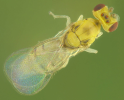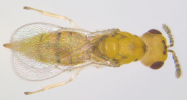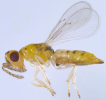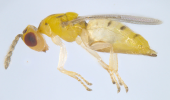 |
Scientific nameQuadrastichus mendeli Kim & La Salle
Taxonomic positionHymenoptera: Chalcidoidea: Eulophidae: Tetrastichinae
DiagnosisFemale: Dorsal side mostly bright yellowish with dark markings as follows: on ocellar triangle, median area of pronotum, latero-posterior corner of pronotum just in front of prothoracic spiracle, apex of axilla, lateral sides of metanotum, median area of propodeum, gaster usually
with 3-4 dark brownish bands on tergites 2-4. Antennae light brownish. Antenna with three funicular segments and one large anellus; all funicular segments longer than wide. Scutellum with two pairs of setae. Fore wing with costal cell without setae, submarginal vein having one dorsal seta in anterior half,
postmarginal vein rudimentary. Abdomen / gaster slightly longer than head and thorax combined (based on Kim & La Salle, 2008).
This is an introduced parasitoid of eucalyptus gall wasp, Leptocybe invasa Fisher & La Salle. ImagesDistribution
Originally described from Australia, introduced in other parts of the world where the eucalyptus gall
wasp is an invasive pest, such as Israel, India, etc. Introduced in India from Israel along with Selitrichodes kryceri Kim & La Salle, but the latter did not establish. Q. mendeli is now established in and around Bangalore (Karnataka) and also in Orissa where releases were made.
Hosts / BiologyA solitary, ectoparasitoid of eucalyptus gall wasp, L. invasa. Known to be uniparental, develops on both young and mature larvae of L. invasa (Kim et al.,
2008).
Reference
|






